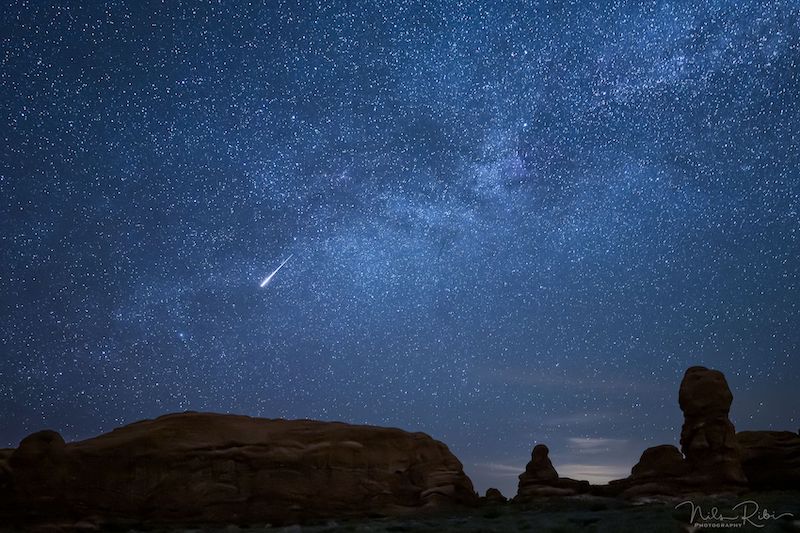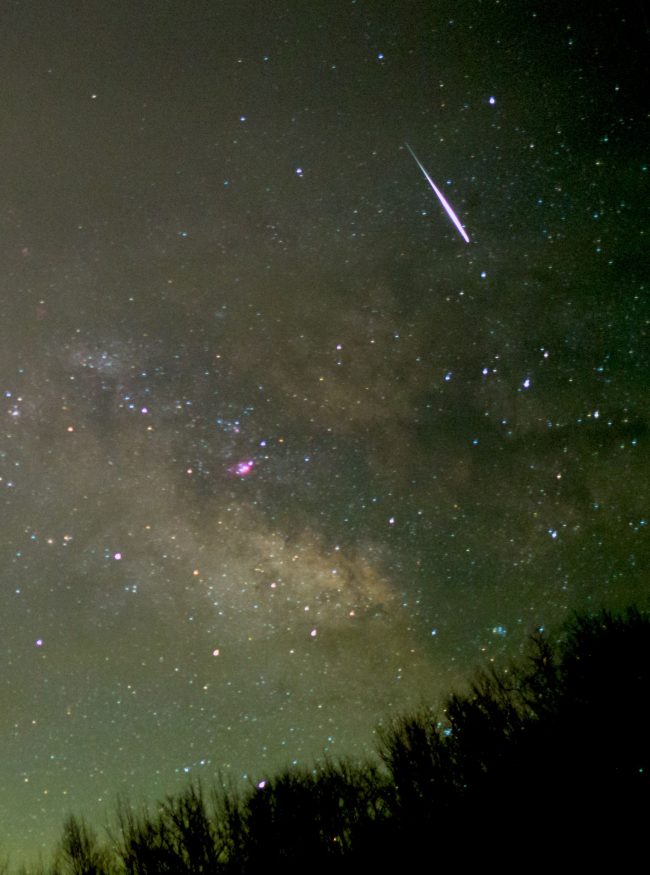
How high up are meteors when they begin to glow?
With the moon waning now, the best time of year for watching meteors is nearly upon us. The Perseid meteor shower will peak on the mornings of August 11, 12 and 13, 2023. Meteors like the Perseids – in annual showers – are leftover dust particles from comets. These bits of cometary debris collide with Earth’s atmosphere and vaporize. We see this collision as a streak of light across the sky – a meteor – or, more poetically, a shooting star or falling star.
But how high up are meteors when they begin to glow?
Meteors light up almost as soon as they hit Earth’s atmosphere. So, on average, when you see a meteor, you’re looking at a piece of dust burning bright about 50 to 75 miles (80 to 120 km) in altitude above Earth’s surface.
On the other hand, the height at which they entirely burn up in the atmosphere varies. Some meteors, such as August’s Perseids, burn up in the atmosphere at about 60 miles (100 km) above Earth’s surface. Other meteors, such as the Draconids in October, fall to about 40 miles (65 km) before they heat up enough to glow and vaporize.
The difference is that the Draconids are much slower meteors than the Perseids. The height in the atmosphere at which a meteor begins to glow depends on its arrival speed. Meteoroids dive into the atmosphere at speeds ranging from 25,000 to 160,000 miles per hour (about 40,200 and 257,500 km per hour).

Speeds for annual showers
There are a dozen major meteor showers every year, and many more minor ones.
Here are some meteor arrival speeds:
Leonids: 44 miles (71 km) per second
Perseids: 38 miles (61 km) per second
Orionids: 42 miles (67 km) per second
Lyrids: 30 miles (48 km) per second
Geminids: 22 miles (35 km) per second
Fall Taurids: 19 miles (30 km) per second
Delta Leonids: 14 miles (23 km) per second
Draconids: 14 miles (23 km) per second
By the way, the length of a meteor’s path across the sky doesn’t depend entirely on the meteor’s arrival speed. It depends mostly on the angle at which the particle of dust slices through the atmosphere. If the particle arrives at a low angle, it enters the atmosphere more gradually, heats up more slowly, and cuts a longer swath across the sky, than if it barrels in at a steep angle.
The size, composition and density of the dust particle probably also affect the length of the path, but scientists still aren’t sure exactly how.
Bottom line: How high up are meteors when they begin to glow? Meteors start glowing almost as soon as they hit Earth’s atmosphere, but tend to vaporize at varying altitudes.
Read more: EarthSky’s meteor shower guide
The post How high up are meteors when they begin to glow? first appeared on EarthSky.
from EarthSky https://ift.tt/GnTHwD5

How high up are meteors when they begin to glow?
With the moon waning now, the best time of year for watching meteors is nearly upon us. The Perseid meteor shower will peak on the mornings of August 11, 12 and 13, 2023. Meteors like the Perseids – in annual showers – are leftover dust particles from comets. These bits of cometary debris collide with Earth’s atmosphere and vaporize. We see this collision as a streak of light across the sky – a meteor – or, more poetically, a shooting star or falling star.
But how high up are meteors when they begin to glow?
Meteors light up almost as soon as they hit Earth’s atmosphere. So, on average, when you see a meteor, you’re looking at a piece of dust burning bright about 50 to 75 miles (80 to 120 km) in altitude above Earth’s surface.
On the other hand, the height at which they entirely burn up in the atmosphere varies. Some meteors, such as August’s Perseids, burn up in the atmosphere at about 60 miles (100 km) above Earth’s surface. Other meteors, such as the Draconids in October, fall to about 40 miles (65 km) before they heat up enough to glow and vaporize.
The difference is that the Draconids are much slower meteors than the Perseids. The height in the atmosphere at which a meteor begins to glow depends on its arrival speed. Meteoroids dive into the atmosphere at speeds ranging from 25,000 to 160,000 miles per hour (about 40,200 and 257,500 km per hour).

Speeds for annual showers
There are a dozen major meteor showers every year, and many more minor ones.
Here are some meteor arrival speeds:
Leonids: 44 miles (71 km) per second
Perseids: 38 miles (61 km) per second
Orionids: 42 miles (67 km) per second
Lyrids: 30 miles (48 km) per second
Geminids: 22 miles (35 km) per second
Fall Taurids: 19 miles (30 km) per second
Delta Leonids: 14 miles (23 km) per second
Draconids: 14 miles (23 km) per second
By the way, the length of a meteor’s path across the sky doesn’t depend entirely on the meteor’s arrival speed. It depends mostly on the angle at which the particle of dust slices through the atmosphere. If the particle arrives at a low angle, it enters the atmosphere more gradually, heats up more slowly, and cuts a longer swath across the sky, than if it barrels in at a steep angle.
The size, composition and density of the dust particle probably also affect the length of the path, but scientists still aren’t sure exactly how.
Bottom line: How high up are meteors when they begin to glow? Meteors start glowing almost as soon as they hit Earth’s atmosphere, but tend to vaporize at varying altitudes.
Read more: EarthSky’s meteor shower guide
The post How high up are meteors when they begin to glow? first appeared on EarthSky.
from EarthSky https://ift.tt/GnTHwD5

Aucun commentaire:
Enregistrer un commentaire